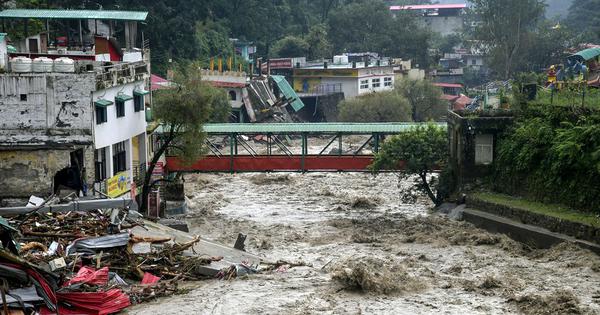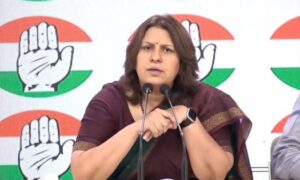
Anyone who has followed news coverage of the monsoon this year would likely assume that several cloudbursts have lashed the Himalayan region. According to media reports, for instance, on just July 1, ten different cloudbursts took place in Himachal Pradesh’s Mandi district, which killed 13 people.
Early this week, too, Dehradun woke up to submerged homes and destroyed roads – the damage had been caused by cloudbursts the night before, news outlets reported. Even the devastating flash flood in Uttarakhand’s Dharali in August that left over 40 missing was initially reported as being a result of a cloudburst.
But officially there is no consensus on whether these events were indeed cloudbursts.
This year, for instance, reports issued by Himachal Pradesh’s state disaster management authorities note that the state experienced 17 cloudbursts between June and September 17.
But when Scroll spoke with officials from regional centres of the Indian Meteorological Department in Shimla and Dehradun, they said that the centres had not recorded a single cloudburst event this monsoon.
What explains this discrepancy?
Interviews with meteorological department and disaster management authority officials revealed that it is a result of the fact that the two use different approaches to classify a heavy-rain event as a cloudburst.
While the meteorological department declares a cloudburst to have occurred when a particular weather station records rainfall of more than 100 mm in one hour, disaster management authorities record events as cloudbursts at the discretion of their field staff.
Experts argue that the problem is not merely a technical one. Rather, they say, when such a widely used term has a lax definition, it could leave room for authorities to deflect responsibility away from themselves when it came to tackling the problem – such as, in the case of excess rainfall, regulating large-scale projects and other such human interventions in the Himalayan region to prevent widespread damage.
“Whenever the term cloudburst pops up, we see a likely shift where the tendency is to just blame it on nature, and that Himalaya is fragile, the phenomenon is inevitable, and we have nothing to do with it,” said Shubhra Sharma, a scientist with the Physics Research Laboratory at the Department of Space in Ahmedabad, who has worked extensively in the Himalayas.
“This needs to change,” she added.
Scroll emailed the Indian Meteorological Department, its regional offices in Shimla and Dehradun, and the state disaster management authorities of Himachal and Uttarakhand, seeking responses to criticisms about the confusion over the term. This story will be updated if they respond.
The IMD’s lack of monitoring capacity
Officials explained that the fact that the meteorological department did not record any cloudbursts this year did not mean that none occurred – rather, it may have failed to do so because it lacked an adequate number of monitoring devices and weather stations.
Anand Sharma, former deputy director general of the regional meteorology centre at Dehradun, explained that a cloudburst can be recorded only if a particular site is equipped with a self-recording rain gauge. Such a gauge records rainfall over the hours it occurs and generates a graph that maps details such as start and finish times of rainfall, and times when it peaked. This chart can clearly indicate instances when the rainfall in an hour exceeded 100 mm.
Currently, however, the departments’ observatories record rainfall over three-hour spells in most places, or over 24-hour periods in smaller stations. “If we were to record for every hour, that would mean we would have to manually ask someone to record it for that hour, which is not possible to do,” said the official from the meteorological department centre in Dehradun, who asked not to be identified by name.
The official at Himachal Pradesh noted, “Such events can happen at any point even in the night, and we cannot put someone at every weather station to record it in case it happens.”
The use of automated weather stations can also help in recording instances of cloudbursts – these devices collect rainfall data every 15 minutes, which can be compiled to arrive at hourly data. As of 2022, Himachal had 22 such stations, while Uttarakhand had 25. But officials from both the states noted that these stations are spread across multiple districts and are separated by large distances, which made it likely that specific occurrences of cloudburst would go undocumented.
“Since cloudbursts are a very localised event, it’s possible that we do not have the AWS where it has rained that much,” said the Dehradun-based official.
Concern with the disaster management authorities’ approach
While meteorological centres may lack adequate capacity to record cloudbursts, experts have even greater concerns about the approach of disaster management authorities.
An official at the Himachal Pradesh disaster management authority explained that they largely relied on inputs from their field staff – these could range from tehsildaars in the revenue department to panchayat officials.
He noted that the authority essentially left it to this field staff to observe situations on the ground and categorise rainfall events. For instance, if staff on the ground observed particularly heavy rainfall during which rainwater entered people’s homes – an unusual occurrence in mountainous regions – they typically term an incident cloudburst. “Whether the event is a cloudburst or not is at the discretion of the field official,” the official said.
Experts reject this method entirely.
Anand Sharma noted that if the staff was not using any equipment, their method of recording cloudburst was “absolutely wrong”.
Others agreed. “Field inputs can’t provide the quantum of rain that objectively identifies cloudburst events,” said Piyoosh Rautela, a freelance disaster-risk reduction consultant, who was also the former managing director at Uttarakhand’s Disaster Mitigation and Management Centre.
He noted that a state disaster management authority could gather comprehensive data on destruction caused during heavy rainfall. But without accompanying rainfall measurements, he added, their conclusions about cloudbursts could be imprecise since significant losses could also occur “in a non-cloud burst event”.
Changes needed
Anand Sharma argued that as a first step towards better monitoring, the government needed to conduct a preliminary study to determine the kind of capacity that is needed. “We need to have an optimum network study to know how many weather stations and recording devices should be there,” he said. “Do we need it every kilometre? Every two kilometres?”
Shubhra Sharma noted that apart from improving monitoring capacity, authorities also needed to arrive at one comprehensive definition of cloudbursts. She explained that the definition should take into account specific natural and human-made factors in the Himalayas, such as specifics of topography or large-scale development projects, which could exacerbate the effects of rain.
Anand Sharma recounted, for instance, that in the devastating June 2013 Kedarnath floods, over the period of two days, the region recorded rainfall of 325 mm. “That time, there was no record of 100 mm rain happening in an hour,” he said. “Even in places where we had the rain gauge, there was no such recording.”
Nevertheless, the damage was unprecedented, he noted. “This shows that even lesser rainfall over several hours can create flash floods in the Himalayas,” he said.
In effect, experts suggested, the present definition may not suffice to capture the range of phenomenon in the Himalaya that can lead to the kinds of devastation associated with heavy rain. “A redefinition will translate into better disaster preparedness,” Shubhra Sharma said.
📰 Crime Today News is proudly sponsored by DRYFRUIT & CO – A Brand by eFabby Global LLC
Design & Developed by Yes Mom Hosting






